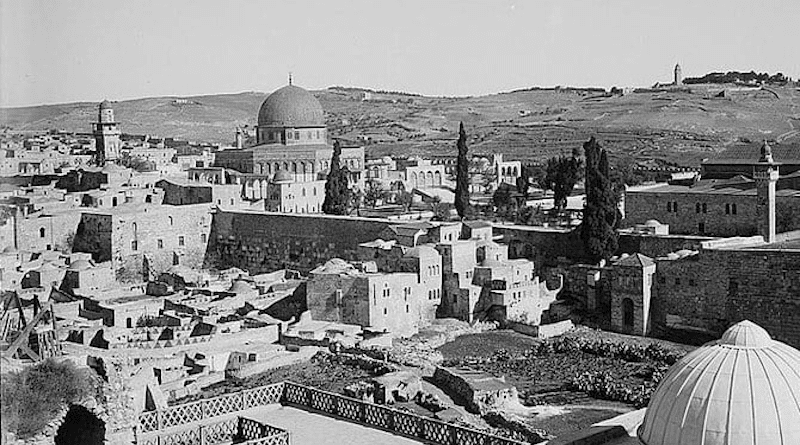Remembering The Moroccan Quarter Tragedy – OpEd
By Ray Hanania
When Moroccan officials, in the spirit of seeking regional peace, joined the UAE and Bahrain in signing the Abraham Accords in December 2020, no one mentioned the history of atrocities committed by Israel against the Moroccan community. That is not to condemn the Abraham Accords, which some believe will pave the way for peace. But it should not be forgotten either as the world focuses on Morocco’s FIFA World Cup achievements.
The issue resurfaced on Saturday, when the Moroccan football team defeated Portugal in the World Cup competition being held in Qatar. The Moroccans in Doha waved Palestinian flags and declared their support for the Palestinians. But when Palestinians in Jerusalem began to celebrate Morocco’s win, they were attacked by Israeli soldiers and police.
The Moroccans’ quarterfinal win and Israel’s brutal response to the subsequent Palestinian celebrations pulled the veil off of a tragic moment that has been airbrushed from history: When the Moroccan Quarter of East Jerusalem, known as Harat Al-Maghariba, was destroyed by Israeli forces at the end of the June 1967 war.
Only days after capturing East Jerusalem on June 7, 1967, West Jerusalem’s Israeli Mayor Teddy Kollek ordered the destruction of the Moroccan Quarter. The Arab world denounced the destruction as a war crime. Despite the atrocity, no real effort was ever made to restore the rights of the homeless residents of the area, who joined the millions of other Palestinian refugees and might have been forgotten had the Moroccan football team not become the first African and first Arab nation to win a spot in the World Cup semifinals. This was an event as historic as the destruction of the Moroccan Quarter was tragic.
During the 1967 operation, Israeli soldiers forcibly evicted more than 100 Palestinian families, a total of more than 650 people, of Moroccan and North African descent. President Chaim Herzog later claimed credit for the demolition, which created a huge plaza for Jewish worshippers to pray. The Western Wall Plaza was originally only a narrow area about 4 meters wide and 57 meters long. But the Israelis razed all of the buildings in the Moroccan Quarter to create a 20,000 sq. meter prayer plaza called the Kotel.
The Israelis rushed to clear the Moroccan Quarter in time for a Jewish holiday on June 14. When residents refused to leave their homes, the military bulldozers began to demolish buildings while people were still inside. One person was killed and a number of others were injured. The Israelis also destroyed the Sheikh Eid Mosque, which was built over one of Jerusalem’s oldest Islamic schools, the Afdiliyeh, to make room for the new plaza.
Even though the Moroccan Quarter was razed to make room for this Jewish religious site, Morocco went on to become only the second North African country after Egypt to sign a normalization agreement with Israel. It is unfortunate that, in the context of that peace accord, the atrocities committed against Moroccans and North Africans were not addressed.
In 2019, Tel Aviv demanded $250 billion in compensation for the properties of Arab Jews who, it asserts, were forced into exile by Morocco, Libya, Tunisia, Iraq, Syria, Egypt, Yemen and Iran following the establishment of Israel in 1948. The Arab countries asserted that Israel urged those citizens to flee their homes and move to the new state. Those Jewish immigrants who moved to Israel received funding to build new homes, many on lands taken from the Palestinians.
Also, often ignored by the pro-Israel media, is the fact that, in the early 1960s, Mossad created a secret network to encourage and help Jews to leave Morocco. In 1959, Morocco’s government adopted a law that prohibited its Jewish citizens from fleeing to Israel. The law, which aimed to preserve the country’s Jewish community, was often cited as a provocation and an act of anti-Semitism by pro-Israel writers.
What happened to Morocco is significant because, before the 1948 war, it boasted the largest Jewish population of any Arab country, at nearly 350,000 citizens.
No one is arguing that there should not be peace or justice for people whose homes were seized and were forced to leave their native lands, but the one-sided argument that Jews were the victims of Arab world racism is an atrocity in and of itself.
America’s ties to Morocco demand that the US recognize the tragedy of the 1967 destruction of the Moroccan community in East Jerusalem. Morocco’s Sultan Mohammed issued a decree in 1777, one year after the US declared its independence from Britain, allowing American ships to dock in its ports. And a decade later in 1786, Morocco became the first nation to recognize the US, signing the Treaty of Peace and Friendship, which is now described as the longest unbroken treaty in American history.
As a young journalist in 1976, I was invited to tour Morocco to write articles about the country. In every city I visited — Marrakech, Rabat, Casablanca, Tangiers and Agadir, with its beautiful beaches and long, low waves — I was welcomed and embraced by citizens who lionized the Palestinian cause. I do not believe that feeling will have dissipated as a result of the recent normalization with Israel.
But I hope that, as part of Morocco’s new relationship with Israel, more can be done not only to restore the rights of Palestinians in the historic lands of Palestine, but also to recognize and remember the tragic suffering experienced by the unarmed families of the Moroccan Quarter, who were forced to flee by Israel in 1967.

